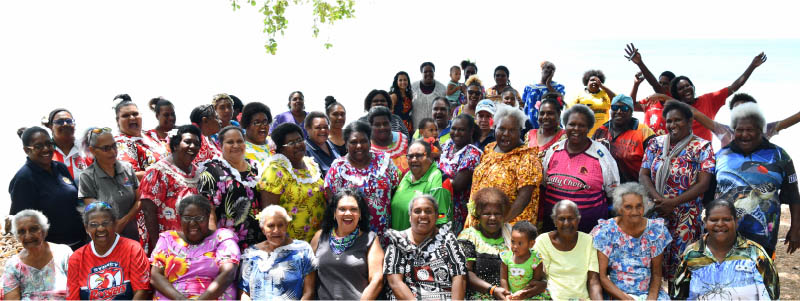Supporting the financial wellbeing of Indigenous women and girls
07 June 2022
5
min read
With Australia’s superannuation system directly tied to paid work, women have a harder time building their superannuation than men, due to being more likely to take time out of the workforce and work part time.1 This can be even more severe for Indigenous women who, due to caring responsibilities and employment challenges, retire with 39% less than non-Indigenous men.2

June Oscar, an Aboriginal woman of Bunuba descent from the Kimberley region in Western Australia, is Australia’s Aboriginal and Torres Strait Islander Social Justice Commissioner and also co-patron of the Women of the World Festivals, which recently met in Cairns to celebrate the achievements of women and girls in Far North Queensland.
During the Cairns festival, Ms Oscar discussed the landmark Wiyi Yani U Thangani (Women’s Voices) – a multi-year project delivered in partnership by the Australian Human Rights Commission and the National Indigenous Australians Agency that aims to elevate the voices and respond to the challenges of First Nations women and girls.
The project began by speaking to First Nations women and girls to produce the Wiyi Yani U Thangani Report. The report was published in 2020, and one of its central themes is financial wellbeing and economic empowerment.
“My team and I traveled to 50 locations in urban, regional and remote areas across every state and territory,” said Ms Oscar, pictured above in the centre of the front row.
We met with more than 2,290 First Nations girls and women of all ages, and many of them told us they need better financial literacy.”
When it comes to Indigenous Australians’ financial wellbeing and literacy:
- Only one in 10 Indigenous Australians are financially secure3
- Fewer than two in five Indigenous people can access $2,000 for an emergency, compared with four in five in the broader Australian population3
- Many Indigenous people in remote communities are unaware of their superannuation entitlements.4
Why do Indigenous women have less super?
Superannuation is a particularly important consideration for First Nations women as they are less likely than any other group to have a retirement that offers more than poverty and deprivation.5 Superannuation can also build intergenerational wealth, but many women often prioritise their families' financial needs and wants over their own financial security.
Australia’s retirement system does not recognise and reward the unpaid caring work that women do, leaving them vulnerable to financial instability or poverty in retirement.
There is also a range of gendered intersectional issues regarding growing superannuation over women's lives, including the gender pay gap, fewer opportunities for promotion and there being no superannuation component of Centrelink payments.
The road to financial wellbeing
The Wiyi Yani U Thangani Report reflects the need for Indigenous women to have better financial literacy and financial counselling to help them manage money and navigate complex financial systems and social security payments.
“Our women have experienced so many barriers to accessing financial services and supports that they are often distrusting and fearful of these systems,” Ms Oscar said.
In wanting to ensure First Nations women can engage in the super system, we have to make it understandable, accessible, and safe and relevant to their lived realities.”
The Wiyi Yani U Thangani Implementation Framework, which followed the report, includes principles, overarching recommendations, and pathways forward.
“The framework recommends ways to make the super system more meaningful and beneficial for our Indigenous women by ensuring that their super contributions can grow even when they are not earning or on low incomes,” Ms Oscar said.
A forum for change
During initial research for the report, the overwhelming message from Indigenous women and girls was that they wanted to come together in a forum, dedicated to them, where they could raise their collective voice and speak directly with governments and multiple stakeholders from business to academia.
The First Nations Women and Girls Summit will take place in May 2023 in Canberra and see Indigenous women and girls discuss with governments and stakeholders how to respond to their needs and invest in social, economic and ecological initiatives that will drive systemic change and achieve First Nations gender justice and equality in Australia.
“First Nations women and girls have never had these frameworks to drive change on their own terms,” Ms Oscar said.
“The Wiyi Yani U Thangani project is a once-in-a-generation opportunity to respond to First Nations women and girls, and break cycles of disadvantage that have harmed so many of our peoples for generations.”
Building better relationships
Australian Retirement Trust is committed to improving the financial wellbeing and empowerment of First Nations people. Find out more about managing your super.
How to stay on top of your super
This content is provided for information purposes only, and the opinions expressed are theirs alone and should not be taken as financial product advice. No responsibility is taken for the accuracy of any of the information supplied and you should seek advice for your circumstances.
1. Workplace Gender Equality Agency. Australian-unpaid-care-work-and-the-labour-market.pdf (wgea.gov.au), accessed 26 May 2022
2. CSIRO and Monash University. Retirement Adequacy of Indigenous Australians, accessed 24 May 2022
3. First Nations Foundation, Money Stories research report conducted in partnership with the Centre for Social Impact and NAB, accessed 26 May 2022
4. Australian Institute of Superannuation Trustees, More work needed to improve Indigenous superannuation outcomes: report, accessed on 26 May 2022.
5. National Aboriginal and Torres Strait Islander Women’s Alliance. Aboriginal and Torres Strait Islander Women & Superannuation report (Economic submission for women in retirement. Submission 65 – Attachment 1), accessed on 26 May 2022.